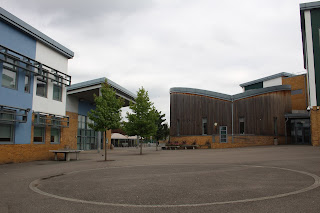Shot #1
Type: Wide shot / establishing shot
We chose this as our first shot in order to set the scene and give the audience a perspective on where the story is taking place. We can tell from the buildings and large free space that this could potentially be a school.
Shot #2
Type: Long shot
Next we chose a long shot in order to introduce our first character from head to toe. The audience can now confirm that this story is taking place in a school as the boy is in school uniform. Although we can't see his face, there is subtle foreshadowing that something bad might happen to the student from the high angle.
Shot #3
Type: Close up
Our third shot is a close up of a one way sign. From the previous shot, the audience can figure out that this sign is present on the stairs (as there are brick walls in both shots). This shot creates suspense as the audience begins to wonder what could happen next and why the sign is being shown in the first place.
Shot #4
Type: Close up
Having this shot immediately after the one way sign shot creates tension as we can see that another student has broken the rule. The fact that we haven't seen that students face yet creates mystery and leaves the audience to think what type of person they are as they have broken a rule. This close up creates even more suspense on what will happen next.
Shot #5
Type: Medium shot
Next we have a medium shot to show how both characters are about to bump shoulders. We can see how the boy is so focused on his book that he doesn't seem to notice, whereas the girl is in a rush and doesn't care. We still haven't seen her face which builds up the mystery on who she could be.
Shot #6
Type: Close up
After witnessing the two characters almost bumping shoulders, the audience is shown a shot of a book on the floor and papers scattered around. We can also see someone picking up the papers and the audience know it's the boy because of his shoe. From this shot the audience can infer that the two characters did bump into each other.
Type: Over-the-shoulder shot
High angle
Our next shot is an over-the-shoulder shot of the boy. This allows the audience to see his facial expression and creates tension. We can see that he is annoyed and is looking at the girl, expecting an apology. However, there is, once again, the subtle hint of the boy's weakness and vulnerability from the high angle of the shot. We still haven't seen the girl's face which creates even more mystery and suspense.
Type: Low angle
The first time we see the girl's face is from a low angle. This shows the audience how she is powerful and big and has an aura of danger around her. She looks angry which creates tension and suspense on what will happen next.
Type: Unusual perspective
The next shot shows how the boy has been the mature one in the situation and has just left the girl and continued his route up the stairs. However, we can see how the girl is still in the same place and she seems very angry- the audience knows this from her fist clenched on the railing. The unusual perspective (bird's eye view) allows us to see both characters although they are on different levels of the stairs.
Type: Big close up
The next shot is a big close up of the girls fist, tightly clenched, as it was in the last shot. The fact that it is a big close up shows the audience that there is going to be a big turning point in the story and depicts how the boy is in big danger.
Type: Medium close up
Over-the-shoulder
The final shot shows both characters from head to shoulders and is therefore a medium close up. The over-the-shoulder shot is quite ironic as it is usually used when two characters are in conversation but we used it here to show the girl about to punch the boy. We can't see both of the characters' faces which creates mystery and leaves the audience to decide how they are feeling in this last moment.
Credits
Victim- Shabd
Bully- Naimah
Camerawoman- Areej











No comments:
Post a Comment